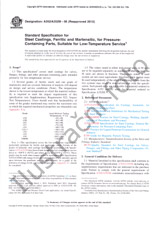Potřebujeme váš souhlas k využití jednotlivých dat, aby se vám mimo jiné mohly ukazovat informace týkající se vašich zájmů. Souhlas udělíte kliknutím na tlačítko „OK“.
ASTM E318-91
Test Method for Uranium in Aqueous Solutions by Colorimetry (Withdrawn 1996)
Automaticky přeložený název:
Zkušební metoda pro uran ve vodných roztocích kolorimetricky (Withdrawn 1996 )
NORMA vydána dne 1.1.1991
Informace o normě:
Označení normy: ASTM E318-91
Poznámka: NEPLATNÁ
Datum vydání normy: 1.1.1991
Kód zboží: NS-46392
Počet stran: 4
Přibližná hmotnost: 12 g (0.03 liber)
Země: Americká technická norma
Kategorie: Technické normy ASTM
Anotace textu normy ASTM E318-91 :
Keywords:
Colorimetric analysis-water, Uranium content-water, Water-radioactive analysis, uranium in aqueous solutions, by colorimetry, test, ICS Number Code 27.120.30 (Fissile materials and nuclear fuel technology)
Doplňující informace
| 1. Scope |
|
1.1 This test method covers the quantitative determination of uranium in known volumes of aqueous solutions that contain radioactive nuclides. These solutions arise from the processing of irradiated nuclear fuel and from laboratory studies on irradiated uranium. 1.2 The applicability of the test method is limited to solutions that contain a minimum of 30 [mu]g of uranium per sample. It will detect as little as 0.5 [mu]g but with lower precision. Highest precision is obtained when 50 to 75 [mu]g of uranium is in the test sample. At concentrations above 750 [mu]g/mL dilutions must be made. The test method as described is limited to sample volumes of 1 mL or less, but reagent volumes can be scaled to accommodate larger sample aliquots or the sample can be concentrated by evaporation. The only known metal ion interferences are thorium and cerium(IV) when present at molar concentrations equal to or greater than the concentration of uranium. Thorium and cerium(IV) have tolerance limits greater than 1000 if the special extraction and scrub solutions are employed. Cerium(IV) present as a fission product does not interfere because its molar concentration is very low compared to uranium. The tolerance limit (no interference at the 95% confidence limit), expressed as the weight ratio of impurity to uranium, is greater than 1000 for silver, bismuth, calcium, cadmium, cobalt, chromium, copper, iron, mercury, lanthanum, manganese, sodium, nickel, lead, strontium, and zinc. The tolerance limit is greater than 100 for barium, beryllium, potassium, magnesium, and zirconium. Plutonium does not interfere when the weight ratio of plutonium to uranium is less than two. The test method is not designed for solutions containing plutonium in the presence of large amounts of thorium or cerium(IV). The tolerance limit is greater than 100 for the following anions: acetate, borate, bromate, chloride, fluoride, ferricyanide, molybdate, oxalate, phosphate, sulfate, persulfate, thiosulfate, and vanadate. The following anions interfere and have tolerance limits as follows: ferrocyanide 2, thiocyanate 58, and tungstate 12. The tolerance limit for free acid is 16 milliequivalents in the sample aliquot. 1.3 The values stated in SI units are to be regarded as the standard. 1.4 This standard does not purport to address all of the safety problems, if any, associated with its use. It is the responsibility of the user of this standard to establish appropriate safety and health practices and determine the applicability of regulatory limitations prior to use. For a specific precaution statement, see Note 1. |
Doporučujeme:
Aktualizace technických norem
Chcete mít jistotu, že používáte pouze platné technické normy?
Nabízíme Vám řešení, které Vám zajistí měsíční přehled o aktuálnosti norem, které používáte.
Chcete vědět více informací? Podívejte se na tuto stránku.




 Cookies
Cookies
